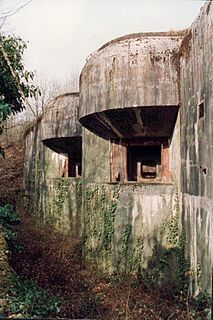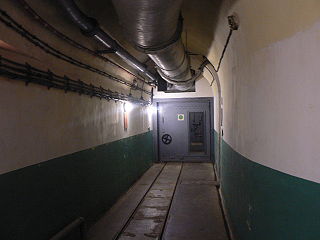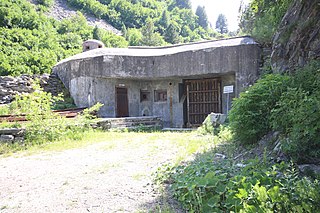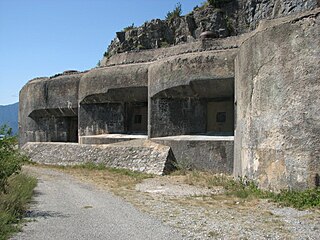
Ouvrage Bovenberg is a lesser work of the Maginot Line. Located in the Fortified Sector of Boulay, the ouvrage is located between petits ouvrages Berenbach and Denting, facing Germany. It consists of two infantry blocks and two artillery blocks.

Ouvrage Billig, a gros ouvrage or large fortification of the Maginot Line, was located in the Fortified Sector of Thionville, Moselle in northern France. It is located between the gros ouvrages Metrich and Hackenberg, facing Germany. It saw relatively little action during World War II and after a period of reserve duty in the 1950s, was abandoned in the 1970s.

Ouvrage Métrich located in the village of Kœnigsmacker in Moselle, comprises part of the Elzange portion of the Fortified Sector of Thionville of the Maginot Line. A gros ouvrage, it is the third largest of the Line, after Hackenberg and Hochwald. It lies between petit ouvrage Sentzich and gros ouvrage Billig, facing Germany. Located to the east of the Moselle, it cooperated with Ouvrage Galgenberg to control the river valley.

Ouvrage Saint-Gobain is a work of the Maginot Line's Alpine extension, the Alpine Line. The ouvrage consists of one entry block, one infantry block, one artillery block, one observation block and one combination block. Located in Modane, France, it is just across the valley of the Arc from Ouvrage Saint-Antoine and somewhat to the east of Ouvrage Sapey.

Ouvrage Le Lavoir Is a work of the Maginot Line's Alpine extension, the Alpine Line, also called the Little Maginot Line. The ouvrage consists of two entry blocks, one infantry block, three artillery blocks and one observation block 6 kilometres (3.7 mi) south of Modane, France, guarding the Col de Fréjus. The surface barracks at Le Lavoir were connected to Charmaix by an aerial tram.

Ouvrage Col du Granon is a lesser work of the Maginot Line's Alpine extension, the Alpine Line. The ouvrage consists of one entry block, one infantry block and one observation block covering the Col du Granon as part of the defenses of Briançon and Grenoble. The ouvrage lies at an altitude of 2,329 metres (7,641 ft).

Ouvrage Restefond is a work of the Maginot Line's Alpine extension, the Alpine Line. The ouvrage consists of one artillery block and three observation blocks at the summit of the Col de la Bonette. The entry block and an artillery block were not completed, and a further block was never built. At 2,733 metres (8,967 ft), Restefond is the highest Maginot ouvrage.

Ouvrage Col de Restefond is a lesser work of the Maginot Line's Alpine extension, the Alpine Line. The ouvrage consists of three infantry blocks. It is located directly adjacent to the Col de Restefond road at an altitude of 2,680 metres (8,790 ft). Construction work was completed in 1934, but the ouvrage was not armed until 1938.

Ouvrage Rimplas is a work of the Maginot Line's Alpine extension, the Alpine Line, known also as the Little Maginot Line. The ouvrage consists of one entry block, two infantry blocks and three artillery blocks at an altitude of 986 metres (3,235 ft). It was the first ouvrage of any portion of the Maginot Line to be completed, in 1928. The ouvrage features an aerial tram entrance.

Ouvrage Col du Caire Gros is a lesser work of the Maginot Line's Alpine extension, the Alpine Line. The ouvrage consists of two entry blocks at an altitude of 2,048 metres (6,719 ft). Additional blocks were planned but not built.

Ouvrage Col du Fort is a lesser work of the Maginot Line's Alpine extension, the Alpine Line. The ouvrage consists of one infantry block and one observation block at an elevation of 1,717 metres (5,633 ft). An additional block was planned but not built.

Ouvrage Gordolon is a work of the Maginot Line's Alpine extension, the Alpine Line, also known as the Little Maginot Line. The ouvrage consists of one and two infantry blocks at an altitude of 728 metres (2,388 ft). Gordolon was built by Borie contractors at a cost of 21.4 million francs. Work started in November 1931 and was completed in April 1934.

Ouvrage Flaut is a work of the Maginot Line's Alpine extension, the Alpine Line, also called the Little Maginot Line. The ouvrage consists of one entry block, one infantry block and one artillery block at an altitude of 771 metres (2,530 ft). The position was intended, acting with Ouvrage Gordolon, to stop an approach by Italian forces from the north towards Nice through the Vésibie Valley.

Ouvrage Baisse de Saint Véran is a lesser work of the Maginot Line's Alpine extension, the Alpine Line. The ouvrage consists of one infantry block facing Italy. Three combat blocks and an entrance block were planned, but only Block 2 was built, with one observation/light machine gun cloche, three light machine gun embrasures and one heavy twin machine gun embrasure at an altitude of 1915 meters. However, armament was never furnished and the cloche was not fitted. Almost none of the supporting subterranean galleries were completed. The position was manned in 1940 by 68 soldiers of the 40th Demi-Brigade des Fusiliers Alpins under Sub-Lieutenant Kessler.

Ouvrage Plan Caval is a lesser work of the Maginot Line's Alpine extension, the Alpine Line, also known as the Little Maginot Line. The ouvrage consists of two infantry blocks and one observation block facing Italy. The ouvrage is located on the heights of L'Authion, surrounded by older fortifications. Three additional blocks were planned to make it a gros ouvrage but were not built. Cost for the full ensemble was estimated at 23 million francs.

Ouvrage Monte Grosso is a work of the Maginot Line's Alpine extension, the Alpine Line, also known as the Little Maginot Line. The ouvrage consists of one entry block, four artillery blocks and two observation blocks facing Italy. It was the largest ouvrage in the Alps It is part of the fortifications surrounding Sospel, which protect the approaches to Nice from the north.

Ouvrage Champ de Tir, also known as Champ de Tir de l'Agaisen is a lesser work of the Maginot Line's Alpine extension, the Alpine Line. It is located at an altitude of 672 metres (2,205 ft), less than 1 kilometer to the northwest of Ouvrage l'Agaisen. The ouvrage consists of two entry blocks and one infantry block, sited to control the valley of the Nieya and to observe for l'Agaisen.

Ouvrage Saint-Roch is a work of the Maginot Line's Alpine extension, the Alpine Line, also known as the Little Maginot Line. Small for a gros ouvrages, the ouvrage consists of one entry block, one artillery block and two observation blocks overlooking Sospel at an altitude of 426 metres (1,398 ft). The position is located just to the southwest of Sospel, its entrance block in a narrow valley and the artillery block on the other side of the ridge overlooking Sospel. The ouvrage is laid out along a single line, with the entry block to the rear, immediately followed by the usine, with barracks farther along and Blocks 2 and 3 at intervals. The position's main armament is concentrated in Block 4, a massive blockhouse designed to protect against rockfalls from higher up the mountain.

Ouvrage Roquebrune is a work of the Maginot Line's Alpine extension, the Alpine Line. The ouvrage consists of one entry block, two artillery blocks and one observation block facing Italy. The fortification is located on the heights behind Roquebrune at an elevation of 321 meters overlooking Cap Martin and the bays of Roquebrune and Menton. The ouvrage was manned by 293 men of the 58th Demi-Brigade Alpin de Forteresse (DBAF), supported by the 157th Régiment d'Artillerie de Position (RAP), under the command of Captain Gayot.

Ouvrage Sainte-Agnès was a work of the Maginot Line's Alpine extension, the Alpine Line, also called the Little Maginot Line. The fortification was built between 1932 and 1938. The site is at the south edge of the hill town of Sainte-Agnès, Alpes-Maritimes at an elevation of 780 metres overlooking the Mediterranean Sea.













